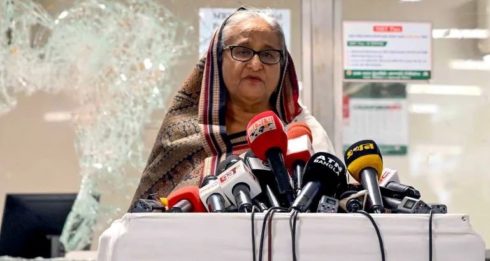In a dramatic turn of events, Bangladesh Prime Minister Sheikh Hasina, 76, has tendered her resignation and fled the country amidst escalating protests. Army chief Waker-Uz-Zaman confirmed these developments, marking a significant upheaval in the nation’s political landscape. The unrest culminated in protesters storming her official residence, as reported by Channel 24, where scenes of chaos included the looting of supplies such as chicken, fish, and vegetables. This tumultuous scene underscored the intensity of public dissatisfaction with the government’s policies.
Reports suggest that Sheikh Hasina departed Dhaka via helicopter accompanied by her sister, although official sources have not yet corroborated her departure. The catalyst for these unprecedented actions appears to stem from widespread demonstrations against a controversial quota system. This system, allocating 30% of government jobs to descendants of 1971 war veterans, ignited public outcry and mass mobilization, prompting calls for Sheikh Hasina’s resignation.
Army Takes Charge Amid Uncertainty over Sheikh Hasina Resignation
As the country grapples with the aftermath of Sheikh Hasina’s resignation, attention now turns to the military’s role in ensuring stability during this transitional period. Army chief Waker-Uz-Zaman is poised to address the nation, a critical moment that will shape the immediate future of Bangladesh. The resignation has left a power vacuum, prompting concerns about governance and the smooth transition of authority.
In response to escalating tensions, the government imposed a comprehensive internet shutdown, ostensibly to curb the unrest and quell dissent. However, this move was met with mixed reactions and did little to dampen the fervor of the protesters, who organized a “Long March to Dhaka” in defiance of these measures. The unfolding situation remains fluid, with stakeholders across Bangladesh closely monitoring developments as the country navigates this period of uncertainty.
Regional Implications and Global Concerns
The resignation of Sheikh Hasina has reverberated beyond Bangladesh’s borders, particularly in neighboring India, where reports suggest she is en route to Tripura’s capital, Agartala. This development underscores the geopolitical ramifications of internal political upheaval within South Asia. International observers are closely watching how events unfold, mindful of the potential implications for regional stability and diplomatic relations.
As Bangladesh transitions to an interim government, questions linger about the nation’s political future and the resilience of its democratic institutions. The coming days will likely see further clarity on the leadership succession and the formulation of policies to address the grievances that fueled the recent protests. Amidst these uncertainties, both domestic and international stakeholders await with bated breath to see how Bangladesh navigates this pivotal moment in its history.
Symbolic Acts and Future Prospects for Bangladesh After Sheikh Hasina Resignation
The unrest in Bangladesh has not only been marked by violence but also by symbolic acts of defiance. Protesters were seen entering Sheikh Hasina’s palace compound, waving to cameras in a moment of victory. Some even smashed statues of Sheikh Hasina’s father, Sheikh Mujibur Rahman, who is celebrated as the country’s independence hero. These actions signify a deep-rooted frustration with the current regime and a desire for significant political change.
The future of Bangladesh remains uncertain as the country navigates through this tumultuous period. The anti-government movement has united various segments of society, indicating a broad-based desire for reform. With the interim government now in place, led by the military, the path ahead will involve addressing the protesters’ demands and ensuring a peaceful transition of power. The international community will be closely watching how Bangladesh manages this crisis and what steps are taken to restore stability and democratic governance.














